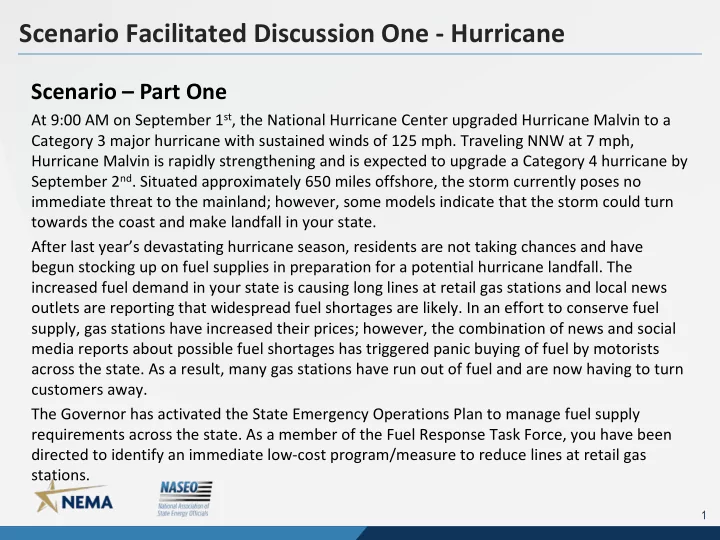

Scenario Facilitated Discussion One - Hurricane Scenario – Part One At 9:00 AM on September 1 st , the National Hurricane Center upgraded Hurricane Malvin to a Category 3 major hurricane with sustained winds of 125 mph. Traveling NNW at 7 mph, Hurricane Malvin is rapidly strengthening and is expected to upgrade a Category 4 hurricane by September 2 nd . Situated approximately 650 miles offshore, the storm currently poses no immediate threat to the mainland; however, some models indicate that the storm could turn towards the coast and make landfall in your state. After last year’s devastating hurricane season, residents are not taking chances and have begun stocking up on fuel supplies in preparation for a potential hurricane landfall. The increased fuel demand in your state is causing long lines at retail gas stations and local news outlets are reporting that widespread fuel shortages are likely. In an effort to conserve fuel supply, gas stations have increased their prices; however, the combination of news and social media reports about possible fuel shortages has triggered panic buying of fuel by motorists across the state. As a result, many gas stations have run out of fuel and are now having to turn customers away. The Governor has activated the State Emergency Operations Plan to manage fuel supply requirements across the state. As a member of the Fuel Response Task Force, you have been directed to identify an immediate low-cost program/measure to reduce lines at retail gas stations. 1
Scenario Facilitated Discussion One - Hurricane Scenario Assumptions § Significant lines of vehicles either develops at retail fueling stations or conditions exist that would make them likely (e.g., decline in fuel supply). § Urban/Suburban communities are likely to be impacted more significantly. § The Governor has implemented “Waivers of Federal Motor Carrier Safety Regulations (Driver Hours of Service)” and “Waivers of Environmental Fuel Specifications.” § Emergency management and industry partners are monitoring petroleum supply to the region. § A public information and messaging strategy has already been developed to deliver information related to the implementation of fuel shortage response programs/measures. 2
Scenario Facilitated Discussion One - Hurricane Discussion Objectives § Execute the provisions required to implement the “ Minimum Purchase Program ” and/or the “ Odd-Even Purchase Program ” in accordance with the program’s implementation procedures (Guidance for States on Petroleum Shortage Planning Response, p.45). § Discuss implementation of the “ Waivers of Federal Motor Carrier Safety Regulations (Driver Hours of Service) ” program (Guidance for States on Petroleum Shortage Planning Response, p.81). 3
Scenario Facilitated Discussion One - Hurricane Scenario – Part Two Situation reports are indicating that panic buying of petroleum products is prevalent across the region and that neighboring states are also experiencing challenges with meeting heightened fuel demands. Despite efforts to mitigate the long lines at retail gas stations, the Governor has declared a State of Emergency and has requested a meeting with emergency managers and ESF #12 representatives from neighboring states to coordinate regional fuel supply requirements. As a member of the Fuel Response Task Force, you have been directed to identify additional fuel response programs/measures that could be employed to address heightened fuel demand. 4
Scenario Facilitated Discussion One - Hurricane Scenario Assumptions § Significant lines of vehicles either develops at retail fueling stations or conditions exist that would make them likely (e.g., decline in fuel supply). § Urban/Suburban communities are likely to be impacted more significantly. § The Governor has implemented “Waivers of Federal Motor Carrier Safety Regulations (Driver Hours of Service)” and “Waivers of Environmental Fuel Specifications.” § Emergency management and industry partners are monitoring petroleum supply to the region. § A public information and messaging strategy has already been developed to deliver information related to the implementation of fuel shortage response programs/measures. 5
Scenario Facilitated Discussion One - Hurricane Discussion Objectives § Identify and discuss alternative fuel shortage response programs/measures and conditions for implementation. § Identify mechanisms to make fuel shortage response program/measure implementation more regionally focused. 6
Recommend
More recommend